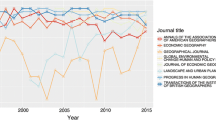Abstract
With the increasing complexity of scientific research and the expanding scale of projects, scientific research cooperation is an important trend in large-scale research. The analysis of co-authorship networks is a big data problem due to the expanding scale of the literature. Without sufficient data mining, research cooperation will be limited to a similar group, namely, a “small group”, in the co-author networks. This “small group” limits the research results and openness. However, the researchers are not aware of the existence of other researchers due to insufficient big data support. Considering the importance of discovering communities and recommending potential collaborations from a large body of literature, we propose an enhanced clustering algorithm for detecting communities. It includes the selection of an initial central node and the redefinition of the distance and iteration of the central node. We also propose a method that is based on the hilltop algorithm, which is an algorithm that is used in search engines, for recommending co-authors via link analysis. The co-author candidate set is improved by screening and scoring. In screening, the expert set formation of the hilltop algorithm is added. The score is calculated from the durations and quantity of the collaborations. Via experiments, communities can be extracted, and co-authors can be recommended from the big data of the scientific research literature.










Similar content being viewed by others
References
Barber MJ, Clark JW (2009) Detecting network communities by propagating labels under constraints. Phys Rev E 80(2):026129
Blondel VD, Guillaume JL, Lambiotte R, Lefebvre E (2008) Fast unfolding of communities in large networks. J Stat Mech 2008(10):155–168
Cardoso B, Sedrakyan G, Gutiérrez F, Parra D, Brusilovsky P, Verbert K (2019) Intersectionexplorer, a multi-perspective approach for exploring recommendations. Int J Hum-Comput Stud 121:73–92
Celebi ME, Kingravi HA, Vela PA (2013) A comparative study of efficient initialization methods for the k-means clustering algorithm. Expert Syst Appl 40(1):200–210
Chauhan S, Girvan M, Ott E (2009) Spectral properties of networks with community structure. Phys Rev E 80(5):056114
Chen S, Wang Z-Z, Tang L, Tang Y-N, Gao Y-Y, Li H-J, Xiang J, Zhang Y (2018) Global vs local modularity for network community detection. PloS One 13(10):e0205284
Donetti L, Munoz MA (2004) Detecting network communities: a new systematic and efficient algorithm. J Stat Mech Theory Exp 2004(10):P10012
Fortunato S (2010) Community detection in graphs. Phys Rep 486(3–5):75–174
Kim J, Hastak M (2018) Social network analysis: characteristics of online social networks after a disaster. Int J Inf Manag 38(1):86–96
Lancichinetti A, Fortunato S, Kertész J (2009) Detecting the overlapping and hierarchical community structure in complex networks. New J Phys 11(3):033015
Lancichinetti A, Radicchi F, Ramasco JJ, Fortunato S (2011) Finding statistically significant communities in networks. PLoS One 6(4):e18961
Li Y, Jia C, Jian Y (2015) A parameter-free community detection method based on centrality and dispersion of nodes in complex networks. Phys A Stat Mech Appl 438:321–334
Lopes, G. R., Moro, M. M., Wives, L. K., De Oliveira, J. P. M. Collaboration recommendation on academic social networks. In: International Conference on Conceptual Modeling (2010), Springer, pp. 190–199
Martin R, Bergstrom CT (2008) Maps of random walks on complex networks reveal community structure. Proc Natl Acad Sci USA 105(4):1118–1123
Newman ME (2004) Coauthorship networks and patterns of scientific collaboration. Proc Natl Acad Sci 101(suppl 1):5200–5205
Newman ME, Girvan M (2004) Finding and evaluating community structure in networks. Phys Rev E 69(2):026113
Parthasarathy S, Ruan Y, Satuluri V (2011) Community discovery in social networks: Applications, methods and emerging trends. Social Network Data Analytics 79–113
Pecli A, Cavalcanti MC, Goldschmidt R (2018) Automatic feature selection for supervised learning in link prediction applications: a comparative study. Knowl Inform Syst 56(1):85–121
Ren Z-M, Zeng A, Zhang Y-C (2018) Structure-oriented prediction in complex networks. Phys Rep
Tian B, Li W (2018) Community detection method based on mixed-norm sparse subspace clustering. Neurocomputing 275:2150–2161
Tibély G, Kertész J (2008) On the equivalence of the label propagation method of community detection and a potts model approach. Phys A Stat Mech Appl 387(19–20):4982–4984
Wang J, Yue F, Wang G, Xu Y, Yang C (2015) Expert recommendation in scientific social network based on link prediction. J Intell 34(6):151–156
Wang Q, Li W, Zhang X, Lu S (2016) Academic paper recommendation based on community detection in citation-collaboration networks. In: Web Technologies and Applications (Cham), F. Li, K. Shim, K. Zheng, and G. Liu, Eds., Springer International Publishing, pp. 124–136
Welch E, Melkers J (2006) Effects of network size and gender on pi grant awards to scientists and engineers: an analysis from a national survey of five fields. In: Annual Meeting of the Association for Public Policy and Management (APPAM)
Yang B, Li X, Liu X, He H, Chen W (2019) Alternating between consensus and leader selection reveals community structure in networks. Phys A Stat Mech Appl 515:693–706
Zhao J, Dong K, Yu J, Kai N (2013) Social network analysis technologies in e-science. E-Sci Technol Appl
Zhao Y-D, Zhou C (2011) The cooperation network of chinese researchers: a perspective of ego-centered social network analysis. Stud Sci Sci 7:999–1006
Author information
Authors and Affiliations
Corresponding author
Additional information
Publisher's Note
Springer Nature remains neutral with regard to jurisdictional claims in published maps and institutional affiliations.
This research is supported by NSFC Grant No.61836013 and CAS 135 Informatization Project XXH13504.
Rights and permissions
About this article
Cite this article
Jin, T., Wu, Q., Ou, X. et al. Community detection and co-author recommendation in co-author networks. Int. J. Mach. Learn. & Cyber. 12, 597–609 (2021). https://doi.org/10.1007/s13042-020-01190-8
Received:
Accepted:
Published:
Issue Date:
DOI: https://doi.org/10.1007/s13042-020-01190-8




